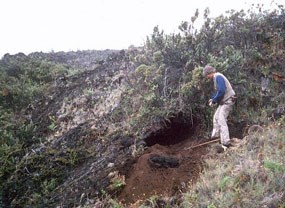
NPS photo. 5. Soil and Sedimentary Charcoal as Evidence of Fire History in Great Smoky Mountains National Park. Sally Horn, Alisa Hass, Chris Underwood, and Matthew Valente, 2004-2009. What scientific questions did researchers ask? Do charcoal fragments in soils and sediments (such as what settles on the bottom of lakes and wetlands) tell the same fire history as tree rings? How far beyond the age of the oldest tree-ring samples can we extend the record of fire history using soil? How did they collect data? Researchers examined soil cores (samples they got from inserting a hollow tube into the soil) taken from five Table Mountain pine stands for charcoal. They also recovered several sediment cores from the wetland at Gum Swamp in Cades Cove to look for charcoal. What did they find? The amount and depth of charcoal in the soil varied quite a bit within single sites and between the five different Table Mountain Pine stands. This means that the stories they told didn’t necessarily match up. Also, the fire history in the soil didn’t show a clear relationship—that is, they didn’t match very well—with the recent fire history that scientists had reconstructed by analyzing tree-rings. By radiocarbon dating the charcoal in the soil (scientists can estimate the age of anything carbon-based), the researchers could clearly see seven fire events in the park. In some locations, soil charcoal may be the only clue about fire history, because trees may have been logged, or died from disease. Dates of the fires range from 150 years before present (with a statistical error of plus or minus 40 years) to 1910 (plus or minus 40 years) before present. The sediments researchers recovered from Gum Swamp in 2007 seem to be only a few hundred years old, rather than thousands of years old as the findings from an earlier study suggested. Results from fine-scale sampling of charcoal in Gum Swamp seemed to show increased fire from the early 1800s to the 1950s, when Euro-American settlers and farmers cleared forests, burned timber, and had regular fires on their lands. The resesarchers found less charcoal in sediments deposited from the 1950s to the present, which is linked to the time when all fire was suppressed in Great Smoky Mountains National Park. If you haven't already, read about fire research in project 1, project 2, project 3, or project 4. Or return to the list of all fire research projects in the Partner profile. |
Last updated: November 12, 2015
